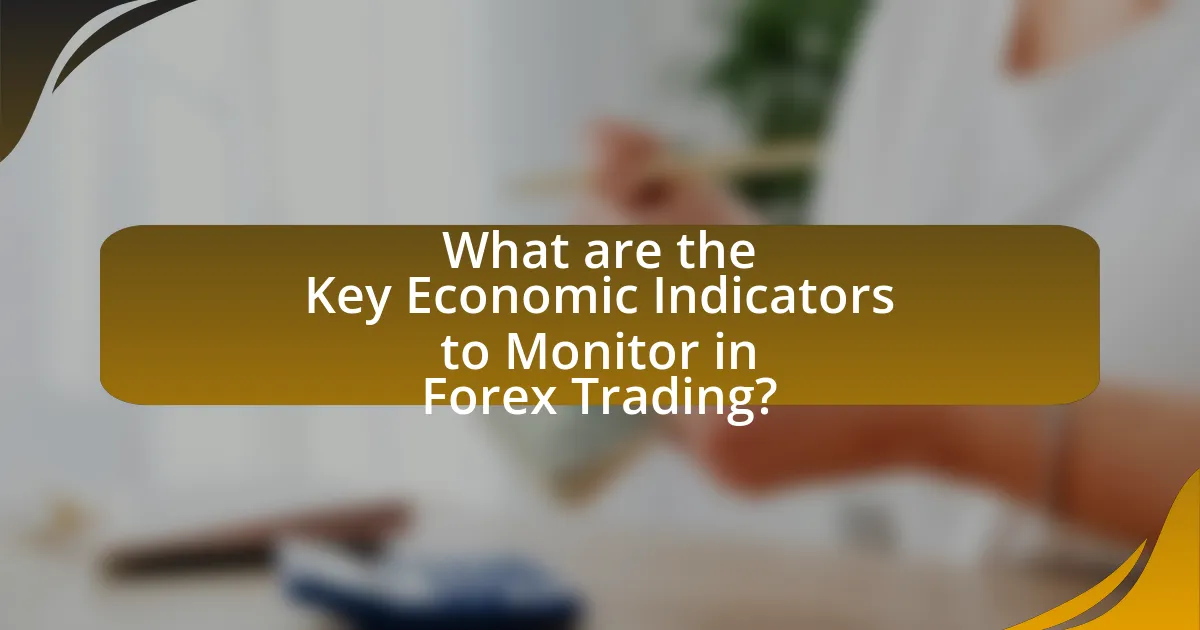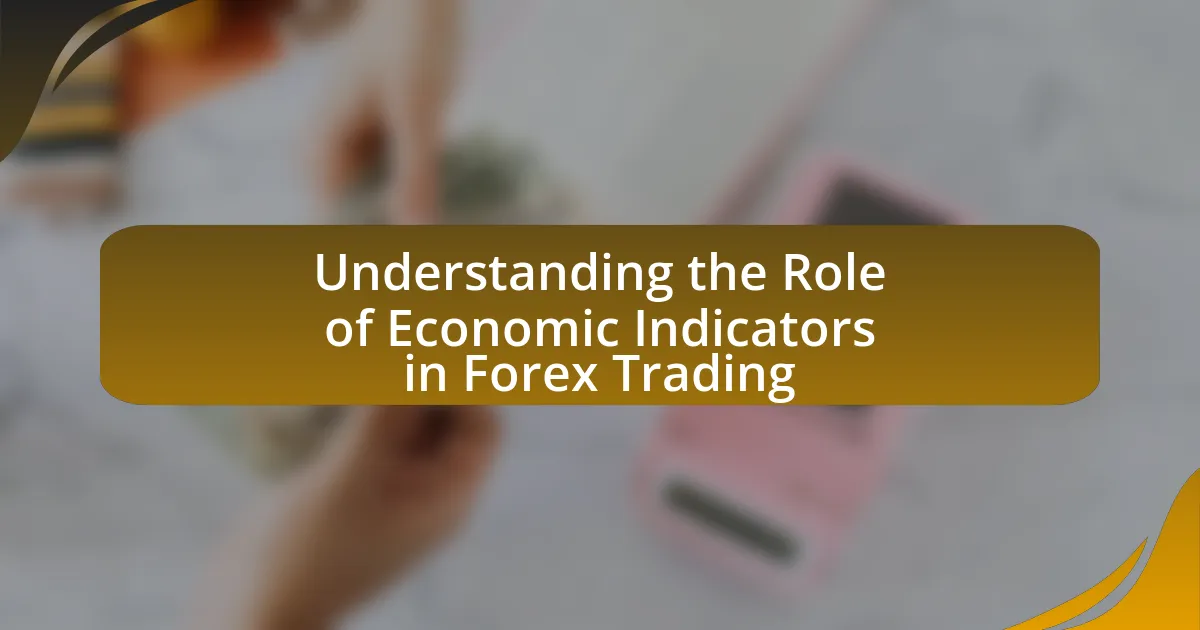Economic indicators are essential statistical metrics that reflect the economic performance and health of a country, significantly influencing currency values in the Forex market. Key indicators such as GDP growth rates, unemployment rates, inflation rates, and consumer confidence indices provide traders with insights necessary for predicting market movements and adjusting trading strategies. The article explores how these indicators impact currency values, the types most relevant to Forex trading, and their role in market predictions. Additionally, it discusses the significance of GDP and employment reports, methods for analyzing economic indicators, and best practices for integrating them into trading plans, ultimately highlighting their critical importance in informed Forex trading decisions.

What are Economic Indicators and Their Importance in Forex Trading?
Economic indicators are statistical metrics that provide insights into the economic performance and health of a country, influencing currency values in the Forex market. These indicators, such as GDP growth rates, unemployment rates, inflation rates, and consumer confidence indices, are crucial for traders as they help predict future market movements and economic trends. For instance, a rising GDP typically signals a strengthening economy, which can lead to an appreciation of the national currency. Conversely, high unemployment rates may indicate economic weakness, potentially resulting in currency depreciation. The importance of economic indicators in Forex trading lies in their ability to inform traders’ decisions, allowing them to anticipate market shifts and adjust their strategies accordingly.
How do Economic Indicators influence currency values?
Economic indicators significantly influence currency values by providing insights into a country’s economic health, which traders use to make informed decisions. For instance, strong economic growth, indicated by rising GDP, typically leads to an appreciation of the currency as it attracts foreign investment. Conversely, high unemployment rates or declining manufacturing output can lead to currency depreciation, as these factors suggest economic weakness. Historical data shows that the release of key indicators, such as the U.S. Non-Farm Payrolls report, often results in immediate fluctuations in the value of the U.S. dollar, demonstrating the direct impact of economic indicators on currency values.
What types of Economic Indicators are most relevant to Forex trading?
The most relevant types of economic indicators for Forex trading include interest rates, inflation rates, employment data, and GDP growth. Interest rates directly influence currency value; for example, higher interest rates typically attract foreign capital, increasing demand for that currency. Inflation rates indicate the purchasing power of a currency; lower inflation generally supports a stronger currency. Employment data, such as non-farm payrolls, reflects economic health and can lead to currency appreciation or depreciation based on job growth or loss. GDP growth measures overall economic performance; stronger GDP growth often correlates with a stronger currency as it indicates a robust economy. These indicators are critical as they provide insights into economic conditions that affect currency valuation.
How do Economic Indicators reflect the health of an economy?
Economic indicators reflect the health of an economy by providing measurable data that indicates economic performance and trends. Key indicators such as Gross Domestic Product (GDP), unemployment rates, inflation rates, and consumer confidence index offer insights into economic activity. For instance, a rising GDP typically signifies economic growth, while high unemployment rates may indicate economic distress. Historical data shows that during the 2008 financial crisis, significant declines in GDP and spikes in unemployment rates were clear indicators of economic downturn, demonstrating how these metrics can effectively gauge economic health.
Why should Forex traders pay attention to Economic Indicators?
Forex traders should pay attention to economic indicators because these metrics provide critical insights into the health of an economy, influencing currency values. Economic indicators, such as GDP growth rates, unemployment figures, and inflation data, directly affect monetary policy decisions made by central banks, which in turn impact exchange rates. For instance, a stronger-than-expected GDP report can lead to an appreciation of a currency, as it may prompt a central bank to raise interest rates to control inflation. Historical data shows that major economic releases, like the U.S. Non-Farm Payrolls report, often result in significant volatility in currency markets, underscoring the importance of these indicators for traders seeking to make informed decisions.
What role do Economic Indicators play in market predictions?
Economic indicators play a crucial role in market predictions by providing quantitative data that reflects the economic health of a country, which traders use to forecast currency movements. These indicators, such as GDP growth rates, unemployment rates, and inflation figures, influence market sentiment and decision-making. For instance, a rising GDP typically signals economic strength, leading to increased investor confidence and potential currency appreciation. Historical data shows that significant economic releases, like the U.S. Non-Farm Payrolls report, can cause substantial volatility in the Forex market, as traders react to the implications of the data on future monetary policy. Thus, economic indicators serve as essential tools for traders to gauge market trends and make informed trading decisions.
How can Economic Indicators impact trading strategies?
Economic indicators significantly impact trading strategies by providing essential data that traders use to forecast market movements. For instance, indicators such as GDP growth rates, unemployment figures, and inflation rates can influence currency values and market sentiment. When a country’s GDP shows strong growth, traders may anticipate a strengthening currency, prompting them to buy that currency in anticipation of appreciation. Conversely, high unemployment rates may lead to a weaker currency, causing traders to sell. Historical data supports this; for example, the release of the U.S. Non-Farm Payrolls report often results in increased volatility in the Forex market, as traders react to changes in employment data. Thus, understanding and analyzing economic indicators allows traders to make informed decisions, aligning their strategies with anticipated market trends.

What are the Key Economic Indicators to Monitor in Forex Trading?
The key economic indicators to monitor in Forex trading include Gross Domestic Product (GDP), unemployment rates, inflation rates, interest rates, and trade balances. GDP measures the overall economic performance of a country, influencing currency strength; for instance, a rising GDP typically strengthens a currency. Unemployment rates indicate labor market health, with lower rates often correlating with stronger currencies. Inflation rates, measured by indices like the Consumer Price Index (CPI), affect purchasing power and monetary policy decisions, impacting currency value. Interest rates set by central banks directly influence currency attractiveness; higher rates generally lead to stronger currencies. Lastly, trade balances reflect the difference between exports and imports, where a surplus can strengthen a currency while a deficit may weaken it. Monitoring these indicators provides traders with insights into potential currency movements and market trends.
What is the significance of GDP in Forex trading?
GDP, or Gross Domestic Product, is significant in Forex trading as it serves as a key indicator of a country’s economic health and growth potential. A rising GDP typically signals a robust economy, which can lead to increased investor confidence and a stronger national currency. For instance, when the U.S. GDP shows growth, it often results in a stronger U.S. dollar against other currencies, as traders anticipate higher interest rates and better returns on investments. Conversely, a declining GDP can indicate economic troubles, leading to currency depreciation. Historical data supports this, as seen in the correlation between GDP growth rates and currency performance during economic cycles.
How does GDP growth affect currency strength?
GDP growth positively affects currency strength by indicating a robust economy, which attracts foreign investment. When a country’s GDP increases, it signals higher productivity and economic health, leading to increased demand for that country’s currency as investors seek to capitalize on growth opportunities. For instance, during the period of strong GDP growth in the United States from 2017 to 2019, the U.S. dollar strengthened against several currencies, reflecting increased investor confidence and capital inflows. This relationship is supported by economic theories that link higher GDP growth rates to stronger currency valuations due to improved trade balances and interest rate adjustments by central banks.
What are the limitations of using GDP as an indicator?
GDP has several limitations as an economic indicator. Firstly, it does not account for income inequality; GDP growth can occur while a significant portion of the population remains impoverished, as evidenced by the disparity in wealth distribution in countries like the United States, where the top 10% hold a substantial share of total wealth. Secondly, GDP fails to measure non-market transactions, such as volunteer work and household labor, which contribute to societal well-being but are not reflected in economic output. Additionally, GDP does not consider environmental degradation; for instance, increased production may lead to pollution, which GDP would count as positive growth despite negative societal impacts. Lastly, GDP is a lagging indicator, meaning it reflects past economic performance rather than current conditions, which can mislead policymakers and investors in dynamic markets.
How do Employment Reports influence Forex markets?
Employment reports significantly influence Forex markets by providing insights into a country’s economic health, particularly through metrics like unemployment rates and job creation. When employment reports indicate strong job growth, it typically leads to an appreciation of the national currency, as investors anticipate potential interest rate hikes by central banks to combat inflation. For instance, the U.S. Non-Farm Payroll report often causes immediate volatility in currency pairs involving the U.S. dollar, as a higher-than-expected job creation figure can strengthen the dollar against other currencies. Conversely, weak employment data can lead to currency depreciation, reflecting concerns about economic slowdown and lower interest rates. Historical data shows that major currency movements often coincide with the release of these reports, underscoring their critical role in Forex trading strategies.
What specific employment metrics should traders focus on?
Traders should focus on specific employment metrics such as Non-Farm Payrolls (NFP), unemployment rate, and average hourly earnings. Non-Farm Payrolls provide a monthly snapshot of job creation in the U.S. economy, which directly influences market sentiment and currency valuation. The unemployment rate indicates the percentage of the labor force that is jobless and actively seeking employment, serving as a key indicator of economic health. Average hourly earnings reflect wage growth, which can signal inflationary pressures and influence monetary policy decisions. These metrics are critical as they are released monthly and can lead to significant market volatility, impacting trading strategies.
How do employment trends correlate with currency movements?
Employment trends significantly influence currency movements, as strong employment data typically leads to currency appreciation. When a country reports rising employment figures, it indicates economic growth, which can attract foreign investment and increase demand for that country’s currency. For instance, the U.S. Non-Farm Payroll report, which measures employment changes, often results in immediate currency fluctuations; a positive report can strengthen the U.S. dollar against other currencies. Conversely, declining employment trends can lead to currency depreciation, as they signal economic weakness and potential monetary easing by central banks. Historical data shows that during periods of low unemployment, such as in the U.S. from 2010 to 2019, the dollar generally strengthened, reflecting the correlation between robust employment figures and currency value.

How to Analyze Economic Indicators for Effective Forex Trading?
To analyze economic indicators for effective Forex trading, traders should focus on key indicators such as GDP growth rates, employment figures, inflation rates, and interest rates. These indicators provide insights into a country’s economic health and influence currency value. For instance, a rising GDP typically signals economic strength, leading to currency appreciation, while high unemployment can indicate economic weakness, resulting in currency depreciation. Historical data shows that the U.S. Non-Farm Payroll report, which reflects employment changes, often causes significant volatility in the Forex market, demonstrating the impact of economic indicators on trading decisions. By systematically evaluating these indicators, traders can make informed predictions about currency movements and enhance their trading strategies.
What methods can traders use to interpret Economic Indicators?
Traders can use several methods to interpret economic indicators, including fundamental analysis, technical analysis, and sentiment analysis. Fundamental analysis involves examining economic data releases, such as GDP growth rates, unemployment figures, and inflation rates, to assess the overall health of an economy and predict currency movements. For instance, a strong GDP growth rate typically signals a robust economy, which can lead to currency appreciation.
Technical analysis, on the other hand, focuses on historical price movements and patterns in conjunction with economic indicators. Traders may use charts and indicators, such as moving averages or the Relative Strength Index (RSI), to identify trends and potential entry or exit points based on economic data releases.
Sentiment analysis gauges market sentiment by analyzing news articles, social media, and trader positioning to understand how economic indicators are perceived by the market. For example, if a positive employment report is released but market sentiment remains bearish, traders may interpret this as a sign of underlying economic concerns.
These methods allow traders to make informed decisions based on economic indicators, enhancing their ability to navigate the forex market effectively.
How can historical data enhance the analysis of Economic Indicators?
Historical data enhances the analysis of economic indicators by providing a context for trends and patterns over time. By examining past economic performance, analysts can identify correlations between various indicators, such as GDP growth and unemployment rates, which can inform predictions about future economic conditions. For instance, the U.S. Bureau of Economic Analysis reported that historical GDP data from the last two decades shows a consistent relationship between consumer spending and economic growth, allowing traders to anticipate market movements based on current consumer behavior. This historical perspective enables more accurate forecasting and risk assessment in Forex trading, as it highlights cyclical patterns and potential anomalies in economic performance.
What tools are available for tracking Economic Indicators?
Tools available for tracking economic indicators include economic calendars, financial news platforms, and data analytics software. Economic calendars, such as those provided by Forex Factory and Investing.com, list upcoming economic events and their expected impacts on markets. Financial news platforms like Bloomberg and Reuters offer real-time updates and analysis on economic data releases. Data analytics software, including Tableau and Microsoft Power BI, allows users to visualize and interpret economic data trends effectively. These tools collectively enable traders to make informed decisions based on the latest economic developments.
How can traders integrate Economic Indicators into their trading plans?
Traders can integrate Economic Indicators into their trading plans by analyzing key data releases and adjusting their strategies based on the anticipated impact on currency values. For instance, traders often monitor indicators such as GDP growth rates, unemployment figures, and inflation data, as these metrics provide insights into a country’s economic health. Historical data shows that significant changes in these indicators can lead to volatility in currency markets; for example, a stronger-than-expected employment report typically strengthens the associated currency. By incorporating a calendar of economic events and setting alerts for major releases, traders can position themselves to capitalize on market movements driven by these indicators.
What are the best practices for using Economic Indicators in trading strategies?
The best practices for using economic indicators in trading strategies include analyzing key indicators, understanding their impact on market sentiment, and integrating them into a comprehensive trading plan. Traders should focus on indicators such as GDP growth rates, unemployment figures, inflation rates, and interest rate decisions, as these directly influence currency values. For instance, a strong GDP growth rate typically signals a robust economy, leading to currency appreciation. Additionally, traders should consider the timing of indicator releases and market expectations, as discrepancies between actual results and forecasts can create volatility. Historical data analysis can also enhance decision-making, as it provides context for how specific indicators have affected currency movements in the past. By systematically incorporating these practices, traders can improve their ability to predict market trends and make informed trading decisions.
How can traders avoid common pitfalls when relying on Economic Indicators?
Traders can avoid common pitfalls when relying on Economic Indicators by diversifying their analysis methods and not solely depending on a single indicator. Relying exclusively on one economic indicator can lead to misinterpretation of market conditions, as indicators can be lagging or subject to revision. For instance, the U.S. Non-Farm Payrolls report often influences market sentiment, but it can be misleading if traders ignore other indicators like unemployment rates or consumer confidence, which provide a broader economic context. Historical data shows that traders who incorporate multiple indicators, such as GDP growth and inflation rates, tend to make more informed decisions, reducing the risk of significant losses.
What are some practical tips for utilizing Economic Indicators in Forex trading?
To effectively utilize economic indicators in Forex trading, traders should focus on understanding the significance of key indicators such as GDP, unemployment rates, and inflation. These indicators provide insights into a country’s economic health, influencing currency value. For instance, a rising GDP typically signals economic growth, which can strengthen the currency. Traders should also monitor the release schedules of these indicators, as market reactions often occur immediately after announcements. Historical data analysis can further enhance decision-making; for example, observing past market responses to similar economic releases can help predict future movements. Additionally, combining economic indicators with technical analysis can provide a more comprehensive trading strategy, as it allows traders to identify entry and exit points based on both fundamental and technical signals.
